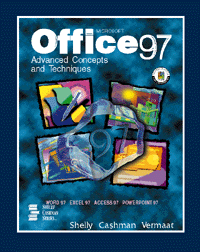Return to
Elective Courses!
NORTHERN KENTUCKY
UNIVERSITY
ADVANCED CONCEPTS AND TECHNIQUES BUSINESS COMPUTING
Course number and section: IFS 490-01
Instructor:David J.
Manning
†
Room Number: B.E.P. 327
Office Number AST 234
Time and day: 1:00-2:15
p.m. M-W
Office Phone 572-5169 Dept. Phone
572-6581
Office Hours:

COURSE
MATERIALS:
Required Text:
Microsoft OFFICE97 Advanced Concepts and Techniques
Author: Shelly, Cashman, Vermaat
IMPORTANT DATES: (Holidays- Drop dates etc.)
I. COURSE
OVERVIEW:
This course will give the undergraduate business student a
strong background in the Windows environment. The applications covered are word
processing using Word97 for Windows, spreadsheets using Excel97 for Windows,
database management systems using Access97 for Windows, and presentations using
PowerPoint97.
II. COURSE
OBJECTIVES:
The overall purpose of this course is prepare
students to integrate computers and computing techniques within their business
degree programs. The goal is for students to develop expertise in the use of
microcomputers and business productivity software through extensive hands-on
laboratory work. Some of the major concepts and applications of computing
include an overview of computerized productivity tools for word processing,
spreadsheets, and database management. Another component of the course focuses
on the use of system software and application software and the role of
computers in database management systems and management information systems.
The students will possess a good working knowledge of the Windows environment
after the completion of the course. After completion of the course students
will possess the knowledge and know how to employ the computer as a valuable
business tool.
III. COURSE FORMAT:
Lecturing and demonstrating (using a computer in class) on
the topics covered in class will be the primary format. Class time will be set
aside for the student to complete the projects found at the end of the
chapters, and for the instructor to work with the students on a one-to-one
basis. The instructor may choose to work with the students as a group in a lab
if one becomes available.
IV. EVALUATIVE
CRITERIA:
In order to arrive at a final grade for the course,
evaluation of a student's performance is made as follows.
Numerical Example: Assignments
average = 85, (Add all assignment grades together and divide by the number of
assignments to get average ( (80 + 85 + 90)/3 to get
85.0))Exam1 = 70, Exam2 = 76, (Average exams (Exam1(70) plus Exam2(76) divided
by 2) = 73.0) total average is assignments average (85) plus average exams (73)
divided by 2 ((85 + 73)/2 = 79)
Grading Scale:
Computer assignments include four primary areas:, 1) Word Processing Using Microsoft Word for Windows, 2)
Spreadsheets Using Microsoft Excel for Windows, 3) Database Using Access for
Windows, 4) Presentations Using Microsoft Powerpoint.
In general students will be expected to complete one Computer Laboratory
assignment at the end of each project. These projects will be judged on their
correctness, neatness, and how well they satisfy the requirements of the
assignment. Points will be deducted if the assignment is received after the due
date. In order for a student to make up an exam the teacher must be informed
either on or before the day of the test if the student is unable to attend the
regularly scheduled exam.
Plagiarism is defined to be "copying or imitating the languages, ideas, and
thoughts of another author and passing off the same as one's original work. "American
College Dictionary
(1961), p. 925." The first offense will result in the student earning a
"0" for the assignment. The second offense will result in the student
earning an "F" for the course and referral to the Dean of Students
for further disciplinary action. See Code of Student Rights and
Responsibilities, Hearing Procedures, Section II. Cheating
and Plagiarism for further details.
Students are fully responsible for learning the content of
this course and for material disseminated in the class. You are not released
from this responsibility because of absences. See Code of Student Rights and
Responsibilities, The Classroom, Class Attendance for further details.
CHANGES TO
SYLLABUS: This is a tentative schedule. The instructor will
do his or her best to cover the material contained in the COURSE OUTLINE but
unforeseen events may occur which preclude us form completing all of the topics
listed in the course outline.
IMPORTANT DATES
Topic Hrs. Area(s)
A. Word97 for
Windows
Creating a Document with a Title Page and Tables 3 C
B. Word97 for
Windows
Generating Form Letters, Mailing Labels, and Envelopes 3 C
C. Word97 for
Windows
Creating a Professional Newsletter with a Table 3 C
D. Excel97
for Windows
Creating Templates, Workbooks with Multiple Worksheets, and
Web Pages 3 C
E. Excel97 for Windows
Data Tables, Visual Basic for Applications, Hyperlinks, and
Scenario Manager 3 C
F. Excel97
for Windows
Sorting and Filtering a Worksheet Database, Pivot Tables,
and Creating a Data Map
3 C
G. Access97
for Windows
Reports, Forms, and Publishing Reports to the Web 3 C
H. Access97
for Windows
Enhancing Forms with OLE Fields, Hyperlinks, and Subfrorms
3 C
I. Access97
for Windows
Creating an Applicationb System
Using Macros, VBA, and the Switchboard Manager 3 C
J.
PowerPoint97 for Windows
Using Embedded Visuals to Enhance a Slide Show 3 C
K.
PowerPoint97 for Windows
Creating a Presentation Containing Interactive OLE Documents 3 C
L. Exams #1
and #2 4 C
M. Lab Time
11 C
Return to Elective Courses!
